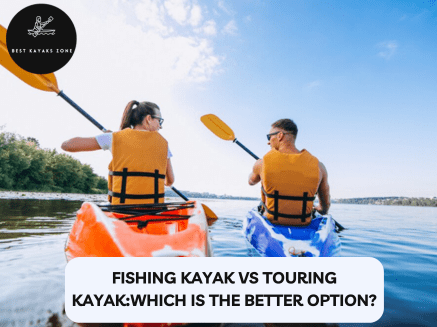
Tessa Young
Kayak Expert

John Smith
Expert Reviewed |Kayak Expert
Update
When comparing a fishing kayaks vs touring kayaks, the right choice depends on your activity needs. Fishing kayaks are stable, equipped for angling, and designed for comfort during long hours on the water. On the other hand, touring kayaks are built for speed, tracking, and covering long distances, making them ideal for exploring lakes and rivers.

On This Page
What is a Fishing Kayak?
A fishing kayak is a vessel uniquely tailored to the angler’s needs, combining the functionality of a traditional kayak with the specialized features necessary for a successful fishing expedition. These kayaks are meticulously designed to provide unparalleled stability, allowing fishermen to cast lines, reel in their catch, and even stand up without fear of capsizing.
The hull of a fishing kayak is often broader and flatter, a deliberate choice to prioritize balance over speed. Equipped with a plethora of accessories such as rod holders, tackle storage, and even electronic mounts for fish finders, fishing kayaks transform the serene act of kayaking into a fully equipped, mobile fishing platform.
Pros and Cons of Fishing Kayaks
Pros
Unparalleled Stability:
Fishing kayaks are designed with a wide hull, ensuring that the kayak remains stable, even when the angler is standing to cast or reel in a fish. This stability is essential for fishing in various water conditions, providing confidence and reducing the risk of capsizing.
Customizable Features:
Fishing kayaks are highly customizable, with many models offering pre-installed rod holders, tackle storage compartments, and mounts for electronics like fish finders or GPS systems. This allows anglers to tailor their kayak to their specific needs, enhancing the overall fishing experience.
Ample Storage:
These kayaks are equipped with plenty of storage options, including hatches, bungee cords, and space for coolers or live bait tanks. This ensures that anglers can carry all the necessary gear and supplies for a full day on the water without feeling cramped.
Ease of Transport:
Despite their robust design, fishing kayaks are relatively easy to transport. Most models are lightweight enough to be loaded onto a vehicle by a single person, making them convenient for solo anglers. Additionally, they can be launched from almost any shoreline, providing access to remote fishing spots that larger boats cannot reach.
Quiet and Stealthy:
Fishing kayaks allow for a silent approach to fishing areas, minimizing disturbances that could scare away fish. This stealth advantage is particularly beneficial when targeting species that are sensitive to noise.
Cons
Reduced Speed and Maneuverability:
The same design that makes fishing kayaks stable also makes them slower and less agile compared to other types of kayaks. Paddling long distances or navigating tight, winding waterways can be more challenging, requiring more effort and time.
Heavier and Bulkier:
Fishing kayaks tend to be heavier and bulkier due to their additional features and wider hulls. This can make them harder to carry, load onto a vehicle, and store when not in use. The added weight may also make it more difficult to paddle in certain conditions, such as strong currents or winds.
Higher Cost:
Fishing kayaks are often more expensive than other types of kayaks due to their specialized features and design. The cost can increase significantly when adding optional accessories like electronic mounts, extra rod holders, or advanced seating systems. This makes them a considerable investment, especially for those new to kayaking.
Limited Versatility:
While fishing kayaks excel in their intended purpose, they are less versatile than other kayak types. Their design is optimized for fishing, meaning they may not perform as well in activities like touring, whitewater paddling, or speed-focused excursions. This specialization can limit their usefulness outside of fishing contexts.
Storage Accessibility:
While fishing kayaks offer ample storage, accessing gear while on the water can sometimes be cumbersome, especially if items are stored in hard-to-reach compartments. This can interrupt the fishing flow, particularly when quick access to equipment is needed.
What is a Touring Kayak?
A touring kayak, often referred to as a sea kayak, is a craft engineered for efficiency over long distances and varied water conditions. Unlike recreational or fishing kayaks, touring kayaks are typically sleek, long, and narrow, designed to cut through the water with minimal resistance.
This design prioritizes speed, straight-line tracking, and the ability to handle rough waters, making touring kayaks ideal for expeditions that require endurance and the ability to navigate unpredictable environments. These kayaks are also equipped with storage compartments, though these are typically watertight and designed for carrying gear over long journeys rather than fishing equipment.
Pros and Cons of Touring Kayaks
Pros
Superior Speed and Efficiency:
Touring kayaks are designed for speed and efficiency over long distances. Their streamlined, narrow hulls cut through the water with minimal resistance, allowing paddlers to cover significant distances with less effort. This makes them ideal for extended journeys on open water, where maintaining a steady pace is crucial.
Excellent Tracking:
The design of touring kayaks emphasizes straight-line tracking, meaning they stay on course even in challenging conditions like strong winds or currents. This ability to maintain direction with minimal corrective paddling is essential for long-distance travel, reducing fatigue and allowing for a smoother, more enjoyable paddling experience.
Durable and Lightweight Materials:
Touring kayaks are often constructed from high-quality materials like fiberglass, carbon fiber, or advanced composites. These materials provide a strong, rigid hull that enhances performance while keeping the kayak lightweight. The combination of durability and reduced weight makes these kayaks easier to handle both in and out of the water.
Ample Storage for Extended Trips:
Touring kayaks are equipped with multiple storage compartments, typically watertight, allowing paddlers to carry gear for multi-day trips. These storage options are designed to keep essentials like camping equipment, food, and clothing dry and secure, making touring kayaks perfect for adventures that span several days.
Adaptability to Various Water Conditions:
Touring kayaks are versatile enough to handle a wide range of water conditions, from calm lakes to choppy seas. Their design provides a balance of stability and performance, allowing paddlers to navigate through waves and rougher waters with confidence. This adaptability makes them suitable for diverse paddling environments.
Cons
Reduced Maneuverability:
While touring kayaks excel in tracking and speed, their long, narrow design can make them less maneuverable, especially in tight spaces. Navigating narrow rivers, winding waterways, or making sharp turns can be more challenging in a touring kayak compared to shorter, wider models like recreational or fishing kayaks.
Less Stability:
The focus on speed and efficiency in touring kayaks often comes at the expense of stability. While these kayaks are stable enough for experienced paddlers, they may feel less secure to beginners or those used to the broader, more stable hulls of recreational or fishing kayaks. This reduced stability can be particularly noticeable in rough water or when entering and exiting the kayak.
Higher Cost:
Touring kayaks are typically more expensive than recreational or fishing kayaks due to their advanced materials, specialized design, and additional features. The investment required for a high-quality touring kayak can be substantial, especially when considering options made from premium materials like carbon fiber.
Storage and Transportation Challenges:
The longer length of touring kayaks, often exceeding 14 feet, can make them more difficult to transport and store. They require more space for storage, and transporting them may necessitate the use of roof racks or trailers, adding to the overall cost and complexity of ownership.
Comfort Considerations:
Touring kayaks are designed for efficiency and performance, which sometimes comes at the expense of comfort. The seating and cockpit design prioritize a snug fit to enhance paddling control, which can become uncomfortable during extended periods of inactivity. While they are comfortable for continuous paddling, they may not offer the same level of cushioning or adjustable features as kayaks designed for leisure or fishing.
Key Differences Between Fishing Kayaks vs Touring Kayaks
Design and Structure
Fishing kayaks and touring kayaks differ fundamentally in design and structure, reflecting their intended uses. Fishing kayaks prioritize width and stability, offering a broader base that allows for easy movement and even standing. In contrast, touring kayaks are designed for speed and distance, featuring a long, narrow hull that slices through the water with minimal resistance. These design choices directly influence the performance characteristics of each kayak, with fishing kayaks offering a stable, stationary platform and touring kayaks excelling in forward momentum and tracking.
Performance and Handling
When it comes to performance and handling, the differences between fishing and touring kayaks are stark. Fishing kayaks, with their wider hulls, are less nimble and slower but provide unmatched stability, crucial for activities like casting and retrieving. Touring kayaks, on the other hand, are designed for speed and efficiency.
They handle well in a straight line, making them ideal for covering long distances on open water. However, their agility in tight turns is compromised compared to the more versatile handling of a fishing kayak.
Comfort and Ergonomics
Comfort and ergonomics are tailored to the specific activities each kayak is designed for. Fishing kayaks often feature adjustable seats, ample legroom, and customizable footrests, making long hours on the water more comfortable.
Touring kayaks, while offering a snug fit that enhances paddling efficiency, may not provide the same level of comfort over extended periods, especially when stationary. The seating in touring kayaks is designed to support the paddler during continuous movement, which can become uncomfortable during prolonged stationary activities like fishing.
Materials and Durability
Both fishing and touring kayaks are constructed from durable materials, but the specific choices often differ based on the demands of each type. Fishing kayaks are typically made from high-density polyethylene, offering durability and resistance to impacts from rocks, stumps, and other obstacles commonly encountered in shallow waters.
Touring kayaks, while also durable, often use lighter, more rigid materials like fiberglass or composite blends to maximize speed and performance. This difference in materials also affects the weight of the kayaks, with fishing kayaks being generally heavier.
Storage and Equipment
Storage and equipment considerations are crucial in distinguishing between fishing and touring kayaks. Fishing kayaks are outfitted with multiple storage options, including built-in rod holders, tackle compartments, and space for coolers or live wells.
This allows anglers to bring all necessary gear without cluttering the deck. Touring kayaks, while also offering storage, focus more on watertight compartments suitable for carrying supplies for long journeys, such as camping gear or emergency equipment.
The storage design in touring kayaks is streamlined to maintain the kayak’s hydrodynamic shape, often at the expense of accessibility compared to fishing kayaks.
Cost and Investment
The cost of fishing and touring kayaks reflects their specialized features and construction materials. Fishing kayaks, with their extensive customization options and durable build, often represent a significant investment, especially when outfitted with high-end accessories.
Touring kayaks, depending on the materials used and design complexity, can also be expensive, particularly if they are made from lightweight composites that enhance performance.
The investment in either type of kayak should be considered in the context of the user’s needs—whether the priority is a stable, gear-laden fishing platform or a sleek, efficient vessel for long-distance travel.
Choosing the Right Kayak for Your Needs
When to Choose a Touring Kayak
A touring kayak is the ideal choice for those who prioritize speed, efficiency, and the ability to cover long distances. If your adventures take you across open waters, through challenging currents, or on extended expeditions that require carrying camping gear and supplies, a touring kayak will serve you well.
Its design is tailored to endurance, making it perfect for those who enjoy the journey as much as the destination. Touring kayaks are also suited for paddlers who appreciate the art of kayaking itself, focusing on technique, speed, and the thrill of navigating vast, open spaces.
When to Choose a Fishing Kayak
A fishing kayak is best for those whose primary focus is the art of angling. If you value stability, storage capacity, and the ability to access remote fishing spots, a fishing kayak is the clear choice.
These kayaks are built to support the needs of the fisherman, with features that make casting, reeling, and gear management as effortless as possible. Fishing kayaks are ideal for calm waters, small lakes, rivers, and even coastal areas where you can find plentiful fishing opportunities.
They offer a mobile, well-equipped platform that brings you closer to your catch without the need for a larger boat.
Final Thoughts
Choosing between a fishing kayak and a touring kayak depends largely on your intended use. Each type of kayak offers distinct advantages tailored to specific activities. Fishing kayaks provide stability, customization, and the ability to carry an array of fishing gear, making them ideal for dedicated anglers.
Touring kayaks, with their speed, efficiency, and capacity for long-distance travel, are perfect for those who seek adventure and endurance on the water. Understanding the key differences between these kayaks will help you make an informed decision, ensuring that your choice enhances your paddling experience, whether you’re reeling in a trophy catch or exploring distant shores.
Final Thoughts
Knowing your weight and the weight of the gear and equipment you plan to bring on your trip is important when purchasing a kayak. The optimal weight restriction provides space for the paddler, gear, and equipment, while the weight limit printed on the boat refers to the greatest load it can support.
When choosing a kayak, think about choosing one with a weight capacity sufficient to hold you and all the stuff you plan to bring.
FAQS:
What is the primary difference between a fishing kayak and a touring kayak?
Fishing kayaks are wider and more stable, designed for anglers. Touring kayaks are long and slim for speed. They’re built to cover more distance. Both serve different needs based on your activities.
Are touring kayaks suitable for fishing?
You can fish from a touring kayak, but it’s not ideal. Touring kayaks are less stable and lack fishing-specific features. They don’t have rod holders or storage for gear. They’re built for paddling over long distances instead.
Which kayak is better for rough waters?
Touring kayaks perform better in rough water due to their streamlined shape. They cut through waves more easily. Fishing kayaks are stable but struggle in strong currents. Choose based on whether you face choppy or calm conditions.
Are fishing kayaks more durable than touring kayaks?
Both types are durable, but fishing kayaks are often tougher. They’re built to handle rough conditions like rocky shorelines. Touring kayaks are lightweight and designed for long paddles. The durability depends on the materials and intended use.
Which kayak is more stable, fishing or touring?
Fishing kayaks are more stable because they’re wider. This makes them ideal for fishing while staying balanced. Touring kayaks are less stable but offer better speed. Choose based on whether you prioritize stability or speed.
Can I use a fishing kayak for touring?
You can use a fishing kayak for touring, but it’s not the best choice. Fishing kayaks are slower and less efficient over long distances. They’re built more for stability than speed. It’s better to use a touring kayak to cover more water quickly.
How does the weight capacity differ between fishing and touring kayaks?
Fishing kayaks have higher weight limits to carry gear and catch. Touring kayaks focus more on lightweight performance. They’re built for speed and efficiency over long paddles. So, fishing kayaks can carry more but are slower.
About Author

Tessa Young
Kayak Expert
Tessa Young is a highly experienced kayak expert with over 8 years of dedicated work in the kayaking industry. Her in-depth knowledge and passion for water sports make her a reliable source of information for kayakers of all levels. Tessa has extensively tested and reviewed a wide range of kayaks, offering expert advice to help readers make informed decisions. Her insights are valued by those looking for trustworthy recommendations on the best kayaks for various needs and environments.
Read More

John Smith
Expert Reviewed | Kayaks Expert
John Smith is an accomplished kayak reviewer with more than 12 years of expertise in evaluating kayak performance and quality. His thorough and unbiased reviews have made him a respected figure among kayaking enthusiasts. John’s extensive experience on the water enables him to provide detailed assessments, focusing on key aspects such as stability, speed, and durability. Readers can rely on John’s expert evaluations to guide them in choosing the right kayak for their adventures.
Read More



